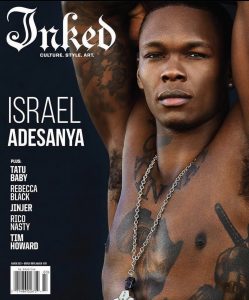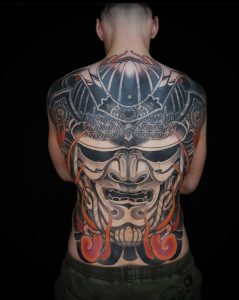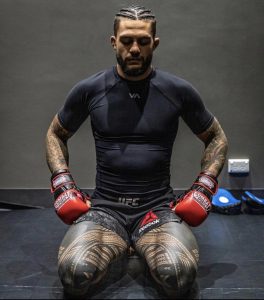Tattoos in the UFC and Mixed Martial Arts
Mixed Martial Arts, also known as MMA, is a full-contact sport combining striking, grappling and ground fighting. It is truly global, incorporating techniques from all over the world from styles such as Brazilian jiu-jitsu, Muay Thai and American Kickboxing. In a way, it is the perfect marriage with tattooing as they both draw inspiration from different cultures, evolving and creating their own unique form of art.
With MMA fights hitting millions of Pay-Per-View buys and highlights racking up many millions more of YouTube highlight-spectators, its lightly dressed stars have also become walking promoters of a wide array of various body art styles. Many of its fighters are adorned with pieces related to the sport as well as life outside the octagon cage.
Broken Native – Israel Adesanya

Israel Adesanya, of Nigerian heritage now fighting out of New Zealand, said in an interview with GQ in 2019 that his advice to anyone wanting to get a tattoo was to just go for it, without overthinking or hesitation, comparing it to how you sometimes need to act in a fight, cause ‘you are going to die anyway and this is not your final form’.
And Israel has a pretty cool collection of tattoos – especially if you are into cartoons and comics. He has a whole range of themes from the Avatar series, as well as a giant portrait of Deadpool on his ribcage, and a homage to Calvin and Hobbes on his inner upper arm. He also has the words ‘broken native’ written across his collarbones, with an image of Africa in the centre of his chest. Not to mention his dragon/crocodile backpiece.
The middleweight champion has recently gone up a weight class to try and knock current light-heavyweight champion Jan Blachowicz (coincidentally ink-free, unless he is hiding something underneath the shorts) off the throne in the title fight of UFC 259 next Saturday.
No gentle giant

Alexander Volkov, the giant Russian heavyweight who recently knocked out Dutch fighter Alistair Overeem, used to have a pretty large-scale blackwork manta ray on his back. Spreading its wings across the fighter’s shoulder-blades, it drew on elements of Polynesian tribal tattooing. This tradition often makes references to the sea and its creatures as spiritual symbols or protectors.
However, as manta rays are known as the gentle giants of the sea, it seems an odd choice to serve as a guardian spirit for a top UFC heavyweight fighter. Perhaps this is why he chose to cover it up with an even larger and somewhat more imposing back-piece. The entire back was done over a period of two weeks, and now ‘Drago’ is as intimidating from the back as he is from the front.
“We did it really quickly because I told the tattoo artist that I need this very quick – one or two weeks. And we did it in two weeks,” Volkov said at the UFC 254 post-fight press conference. “It was really painful, it was (expletive) painful. He did say, ‘You want to do this? You’re sure?’ And I said, ‘I’m sure. I don’t have time. I just need to go to camp for my first time.’ So he said, ‘OK – two weeks.’”
The Polynesian heritage

A more direct Polynesian application can be found on the chest, shoulder and sleeve of middleweight Hawaiian fighter Bradley Kaipo Sarbida Tavares. His piece is a beautiful interpretation of the very roots of tattooing as we know it.
From the other side of the Pacific, Australian MMA fighter Tyson Pedro who competes in the Light Heavyweight division is of Spanish and Samoan descent. Tyson, who is named after boxing heavyweight champion Mike Tyson, has seven different black belts from various combat styles. However, he also sports beautiful Pe’a tattoos. P’ea is the name of the traditional male Samoan tatau, usually received as mark of honour and achievement.
